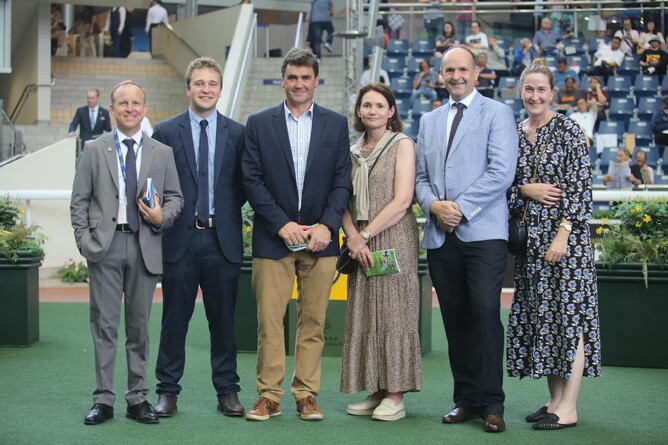As my time in the UK came to a close, I headed off to Hong Kong for the next chapter of my scholarship. On my first day, I visited the Hong Kong Jockey Club headquarters at Happy Valley racecourse.
From the moment I stepped inside, I was amazed by the scale and professionalism of the operation. The office itself was enormous, and it was immediately clear that this was a world-class organisation operating at an entirely different level.
My first stop was meeting up with Danny Rolston, former New Zealand Bloodstock Director of Sales. It was fantastic to catch up with him, and he generously shared insights into his role as well as an overview of the HKJC’s broader operations.
While I had always known the club was impressive, spending two weeks there gave me a whole new level of respect for the organisation. The scale, attention to detail, and seamless coordination required to manage racing, training, and breeding at such a high level was extraordinary.
Danny gave me a tour of the Happy Valley racecourse facilities. Following the tour, I was privileged to take part in the HKJC Bai San — a traditional ceremony held at the start of each racing season to bless the horses and wish everyone safety and success.
The ceremony is deeply rooted in Chinese culture and is performed across every stable and the Club itself. Being part of it was humbling and unforgettable. I was struck by the sense of community, respect, and care for everyone involved — it was a beautiful reminder that racing is not just about competition, but also about shared culture and tradition.
Much of my first week was spent at Sha Tin, where I spent a morning shadowing one of the Club’s veterinarians. Observing the vets at work, I was impressed by their precision and thoroughness. The attention to detail, horse welfare standards, and professionalism of the staff were remarkable and reinforced just how critical this aspect of the operation is to the HKJC’s overall success.
I also spent time with Jamie Richards, who shared his experiences training in Hong Kong and the adjustments required to manage horses in such a different climate. Jamie was incredibly generous with his time, providing insights into training strategies, stable management, and the logistical challenges unique to Hong Kong. It was invaluable to learn from a premiership-winning trainer and gain his perspective on the local industry.
The opening day of the Hong Kong season was a highlight. Despite less-than-ideal weather, over 43,000 people attended Sha Tin to celebrate the start of the campaign. The energy of the crowd was incredible, and seeing the New Zealand-bred Ka Ying Rising kick off his Everest campaign with a commanding win was thrilling.. I attended three race days in total while in Hong Kong, including a spectacular Wednesday night meeting under the lights at Happy Valley — an experience every racing fan should witness at least once.
A unique part of my time was sitting in on the handicapping meetings with Greg Carpenter, the Head of Handicapping. Seeing the system in action and understanding how it differs from New Zealand and Australia was fascinating. I was struck by how detailed and data-driven their approach is, and how it directly impacts the competitiveness of races in Hong Kong. Another highlight was visiting Beas River, the HKJC’s thoroughbred retirement programme. The facilities were top class, and it was incredible to see the level of care dedicated to ensuring horses transition successfully after racing.
One of the most memorable experiences was visiting the Conghua racecourse and stabling facilities in China, which act as a “satellite” base for Hong Kong trainers. It was fascinating to see how the different environment, climate, and track surfaces affected training routines. The contrast with Sha Tin highlighted the adaptability required in horse management and reinforced the importance of understanding context when preparing horses for racing.
Although my time in Hong Kong was only 16 days, it was packed with learning opportunities. I am extremely grateful to Danny Rolston and his assistant, Keyo Chan, for coordinating such an incredible insight into every corner of the HKJC. It was an experience that deepened my understanding of international racing operations and broadened my perspective on what is required to succeed at the highest level.
From Hong Kong, I flew to Sydney for my next placement with Kick Collective, a marketing agency specialising in the thoroughbred industry. My time at Kick Collective was phenomenal. Seeing the creativity, precision, and dedication required to produce high-quality content for leading studs and trainers was eye-opening. One highlight was filming at Randwick with Gai Waterhouse. Her attention to detail, infectious energy, and quick wit made it an unforgettable morning and gave me an insight into how media and marketing intertwine with racing.
I was also involved in preparations for National Thoroughbred Week, an initiative designed to showcase the care, passion, and professionalism of the thoroughbred industry to the public. It is such a fantastic initiative and is promoting the sport in such a positive and educational way.
Reflecting on the past month, this stage of my scholarship has been both exhilarating and humbling. From the scale and structure of the HKJC, to the innovation and creativity of Kick Collective, I’ve gained a broader appreciation for the different ways people contribute to the racing industry.
These experiences have reinforced the importance of observation, adaptability, and lifelong learning. My next stop is four weeks at Chris Waller Racing, and I am excited to continue building on these experiences with another world-class New Zealand-bred trainer.


